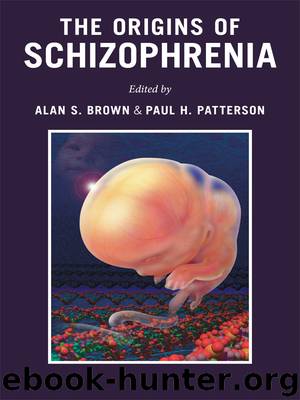The Origins of Schizophrenia by Brown Alan; Patterson Paul;

Author:Brown, Alan; Patterson, Paul;
Language: eng
Format: epub
Tags: Psychology/Mental Illness
Publisher: Columbia University Press
Published: 2011-08-20T16:00:00+00:00
Determining the Pathogenic Nature of CNVs and Affected Genes
The identification of CNVs as an important source of variation in the human genome and the connection between rare CNVs and psychiatric disorders raises the question of how to distinguish abnormal structural mutations from neutral polymorphisms and establish a causal relationship between pathogenic CNVs and their corresponding phenotypes. Establishing causality may be easier for recurrent CNVs if a sufficient number of patients is available. In such cases, establishing a bidirectional association between CNVs and disease along the lines described here for the 22q11.2DS is important to strengthen causality and facilitate development of diagnostic assays. Specifically, in addition to enrichment among cases, unambiguous association between a CNV and schizophrenia requires demonstration of relatively high penetrance among CNV carriers (higher than the baseline rate of psychosis in mental retardation), as well as meeting full diagnostic criteria indistinguishable from those of individuals with schizophrenia that are not CNV carriers.
Establishing causality is harder for private CNVs found in only a single individual, which represent the majority of CNVs described to date in patient cohorts. In such cases, determining a possible causal connection between a specific CNV locus and a disease phenotype depends on a number of factors. For example, a rare de novo CNV is more likely to be pathogenic than a CNV inherited by an unaffected parent. For inherited CNVs, cosegregation with disease is a strong indicator of causal connection between disease and the CNV. In particular, the observation that all affected members of a family carry a rare CNV is a strong indication of pathogenicity. (It is not detrimental if unaffected members also carry it if there is incomplete penetrance.) The issue of whether a potentially pathogenic CNV segregates to all affected members within a family has not received much attention in the current literature, which is heavily based on case-control studies. This is a source of concern, as it may lead to false findings. Finally, CNVs that affect the coding region or the splicing pattern of a given gene are more likely to be pathogenic than, for example, intronic or intergenic CNVs. Overall, support for a pathogenic role can be offered by the location of a CNV in a given gene as well as by observation of recurrent incidence of independent CNVs in more than one exon of the same gene or members of the same gene family.
Help toward establishing causality may be provided by reference CNV maps across the whole genome and by online databases that are being established. The Database of Genomic Variants (DGV) (see http://projects.tcag.ca/variation) is such an accumulation of data, which as of this writing holds reports on over 8,400 CNV loci. It also provides public access to the Genome Structural Variation Consortium results from high-resolution CNV scans on 40 individuals with European or African ancestry. By offering a compendium of current findings, this database is especially valuable to determine whether newly discovered CNVs are unique to one’s case population or found at relatively high frequency among controls in prior reports.
Download
This site does not store any files on its server. We only index and link to content provided by other sites. Please contact the content providers to delete copyright contents if any and email us, we'll remove relevant links or contents immediately.
Periodization Training for Sports by Tudor Bompa(7902)
Why We Sleep: Unlocking the Power of Sleep and Dreams by Matthew Walker(6330)
Paper Towns by Green John(4780)
The Immortal Life of Henrietta Lacks by Rebecca Skloot(4239)
The Sports Rules Book by Human Kinetics(4063)
Dynamic Alignment Through Imagery by Eric Franklin(3908)
ACSM's Complete Guide to Fitness & Health by ACSM(3810)
Kaplan MCAT Organic Chemistry Review: Created for MCAT 2015 (Kaplan Test Prep) by Kaplan(3790)
Introduction to Kinesiology by Shirl J. Hoffman(3617)
Livewired by David Eagleman(3528)
The River of Consciousness by Oliver Sacks(3403)
The Death of the Heart by Elizabeth Bowen(3330)
Alchemy and Alchemists by C. J. S. Thompson(3287)
Descartes' Error by Antonio Damasio(3156)
Bad Pharma by Ben Goldacre(3085)
The Gene: An Intimate History by Siddhartha Mukherjee(2913)
The Emperor of All Maladies: A Biography of Cancer by Siddhartha Mukherjee(2905)
The Fate of Rome: Climate, Disease, and the End of an Empire (The Princeton History of the Ancient World) by Kyle Harper(2851)
Kaplan MCAT Behavioral Sciences Review: Created for MCAT 2015 (Kaplan Test Prep) by Kaplan(2807)
